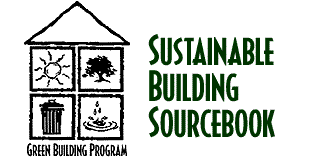
|

|
 |
Check out the Green Building Professionals Directory! |
CONSIDERATIONS:
In selecting material for roof covering one should take into account its weight (heavier material requires larger support members), its durability (e.g. how well can it tolerate high and low temperatures and for how long), its effect on water falling on the roof if the water is being captured (for example, will gravel from shingles build up sediment in a cistern or do roof materials leach into the water?), the heat-holding qualities of the roof material (does it heat up and stay hot into the night?), as well as cost, fire rating, maintainability, and installation characteristics.
Slate, clay, and cementitious roof materials offer excellent durability but are heavy. Fiber-cement composite roof materials are somewhat lighter and use fiber materials resourcefully. Some use waste paper as well as wood fiber. Many have 60 year warranties.
Metal roof materials, steel and aluminum contain high percentages of recycled content, up to 100% in many aluminum products. An additional advantage is that these materials are easily recycled in their post-use as well as lightweight and durable.
Asphalt shingles use recycled, mixed paper in their base and some use reclaimed minerals in the surface aggregate. This type of material does not last as long as the others mentioned above. Recycled plastic roof materials are starting to be introduced as a lightweight option.
| Commercial Status |
Implementation Issues |
||||||
|---|---|---|---|---|---|---|---|
| Clay/Cemetitious | |||||||
| 30-50 Year Material | |||||||
| Recycled Content | |||||||
| Legend | |
|---|---|
| Satisfactory |
|
| Satisfactory in most conditions |
|
| Satisfactory in Limited Conditions |
|
| Unsatisfactory or Difficult |
|
CertainTeed Corporation
Classic Products
Eternit
Gerard Roofing Technologies, Inc.
James Hardie Building Products
Masonite Corporation
Maxitile, Inc.
Metal Sales Manufacturing Corp.
Nailite International
D'Hanis Brick and Tile Co.
Elgin-Butler Brick
Vail Metal Systems
GAF
MetalWorks
Perfect Choice Building Products
Re-New Wood, Inc.
National Tile Roofing Manufacturing Assn.
Underwriters Laboratory
American Society for Testing and Materials
return to
Sourcebook Contents |
Search Sustainable Sources |
Green Building Conferences |
Bookstore |
Sustainable Building Calendar |
Green Building Professionals Directory
This file last updated on Tuesday, August 20, 2002
FINANCING:
Available.PUBLIC ACCEPTANCE:
Most people prefer shingle, tile, or slate roof materials; metal shingles are available as an option to metal sheet materials.REGULATORY:
Roofing materials will meet standards established by the appropriate testing groups and must be installed according to the manufacturers instructions.
GUIDELINES1.0 Fiber-cement composite slates and shakes
RESOURCES
PROFESSIONAL ASSISTANCE
See "Building Construction Consultants" and ""Roofing Services Consultants" in Yellow Pages.
COMPONENTS / MATERIALS / SYSTEMS
See "Roofing Contractors", "Roofing Equipment and Supplies", and "Roofing Materials" in Yellow Pages.
American Cem-Wood Products
P. O. Box C
Albany, OR 97321
(800) 367-3471
www.cemwood.com
"Cascade and Royal Shakes(TM)" and "Pacific Slate(TM)" fiber -cement roofing tiles, 30 year warranty, 480-620 pounds per square, Class A fire rating.
3303 E. 4th Ave.
Shakopie, MN 55379
(800) 328-5874, (800) 274-8530
Organic felt based shingles with recycled-content, Class C fire rating.
299 Staunton St., P. O. Box 701
Piqua, OH 45356
(513) 773-9840
Rustic Shingle recycled aluminum shingles, 40 year limited warranty, 45 pounds per square, Class A, B, or C ratings according to underlayment, enamel acrylic paint finish approved for drinking water catchment.
Excelsior Industrial Park, P. O. Box 679
Blandon, PA 19510-0679
(215) 926-0100
Fiber-cement slates, average 430 pounds per square, Class A rating, 30 year non-prorated warranty.
955 Columbia Street
P. O. Box 9459
Brea, CA 92622-9459
PH: (800)-23-ROOFS (714)-529-0407
FX: (714)-276-1476
http://www.gerardusa.com
info@gerardusa.com
Steel (G-90 Galvanized or AZ-50 Gavalume) Tile & Shake roof panels coated with graded stone granules & accessories, 140 pounds per square, Class A rating, 50 year warranty.
26300 La Alameda Suite 400
Mission Viejo, CA 92691
(800) 426-4051
www.jameshardie.com
Hardishake(R) & Hardishingle(R) fiber cement tiles, 380 lbs per square, Class A rating, 50 year warranty.
1 South Wacker Drive
Chicago, IL 60606
(800) 255-0785
Woodruf(R) shingles from reconstituted wood fibers, 230 pounds per square, 25 year limited warranty, simulate natural cedar appearance.
17141 S.Kingview Ave.
Carson, CA 90746
(800) 845-6293
Fiber-cement tile, 340 pounds per square, Class A rating, 50 year warranty, simulate mission tile appearance.
3838 North General Bruce Drive
Temple, TX 76501
(800) 543-4415
Stile(TM) metal tile, 100 pounds per square, Class A rating, 20 year limited warranty, Simulate clay tile appearance.
1251 Northwest 165th St.
Miami, FL 33169
(800) 624-5483
Recycled-content plastic panels, 80 pounds per square, Class C rating.
311 E. Nacoma
San Antonio, TX 78216-2714
(800) 299-9399
Clay tile
1009 E. 40th St.
Austin, TX 78751
(512) 453-7366
Clay tile
P.O.Box 6521
Vail, CO 81658
(888) VAILMETL,
www.vailmetal.com/roofing/
copper and Kynar 500 galvalume panels
1361 Alps Rd
Wayne, NJ 07040
(800) 223-1948
Fiber-cement shingles, slates, shakes, 240-500 pounds per square, Class A and B ratings, 40 year non-prorated warranty
1005 Beaver Grade Road
Moon Township, PA 15108-2944
(800) 320-0101
Aston Wood Steel shingles, 63 pounds per square, 5 Kynar 500 colors available, Simulate wood shake appearance
Local Distributor:
Pan Am Distributing, (512) 836-1531
ATAS International
6612 Snowdrift Road
Allentown, PA 18106
(800) 468-1441 or
4559 Federal Blvd.
San Diego, CA 92113
(800) 879-8382
www.atas.com
Steel and Aluminum shingles, 35-60 lbs. per sq. for aluminum, 80-140 lbs per sq. for steel, Class A rating, 25 yr. warranty ,the look of shake, slate, or tile, (4) Kynar 500 colors
Local Dealer:
Pan Am Distributing, (512) 836-1531
1618 Lynch Rd.
Evansville, IN 47711
(800) 776-8060
interlocking thermoplastic shingles with cedar shake appearance, Class A flame protection, 62 lbs per square
P.O.Box 1093
Wagoner, OK 74467
(800) 420-7576
Eco-Shake(TM) 100% recycled plastic/wood shingle, 250 lbs/sq, 50 yr warranty, 4 colors , Class A fire rating
Local Distributor:
Polston Sales & Marketing
(972) 258-6255
Cal-Shake Corporation
5355 N. Vincent Ave.
Irwindale, CA 91706
(818) 969-7544
fiber-cement shake-like and slate-like roofing tiles, 25 year warranty
Vincent Metal Goods
P.O.Box 360
Minneapolis, MN 55440
(800) 328-7800
"ColorKlad" and "AlumaKlad" standing seam metal roofing panels
Protective Coatings of Austin
2210 S. 1st St., Suite G1
Austin, TX 78704
(512) 462-1094
reflective,insulating, ceramic roof coating
GENERAL ASSISTANCE
Metal Roofs
RR2, Box 146
Richmond, VT 05477
Send stamped self addressed envelope for
detailed information on metal panels
installation.
3127 Los Feliz Blvd.
Los Angeles, CA 90039
(213) 660 4411
333 Pfingsten Road
Northbrook, IL 60062
Standards for fire ratings
1916 Race St.
Philadelphia, PA 19103
(610) 832-9500
Standards for aluminum, slate, asphalt, steel




Water
Energy
Building
MaterialsSolid Waste



![]()
Sustainable Building Sourcebook web version copyright Sustainable Sources 1994-2000.